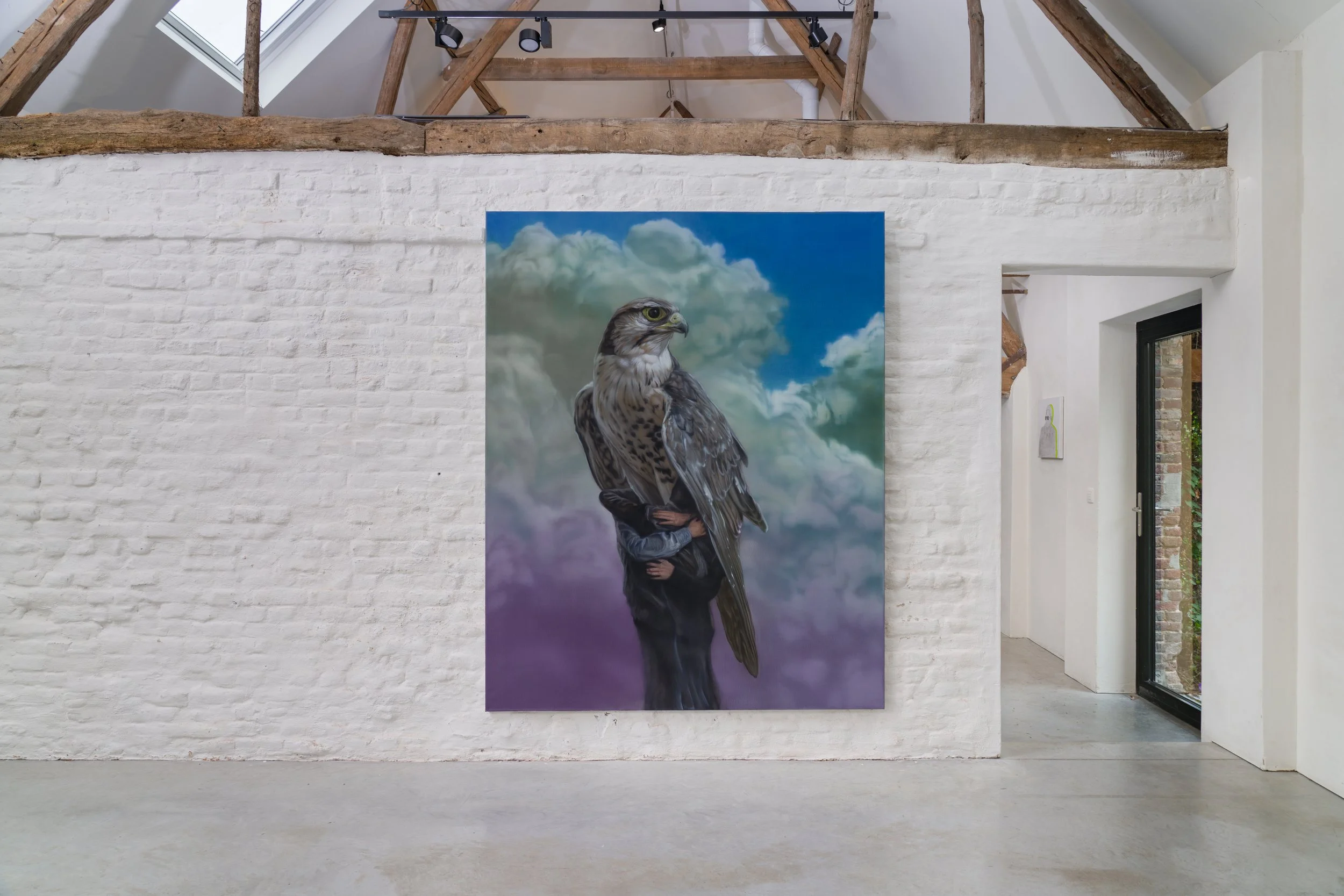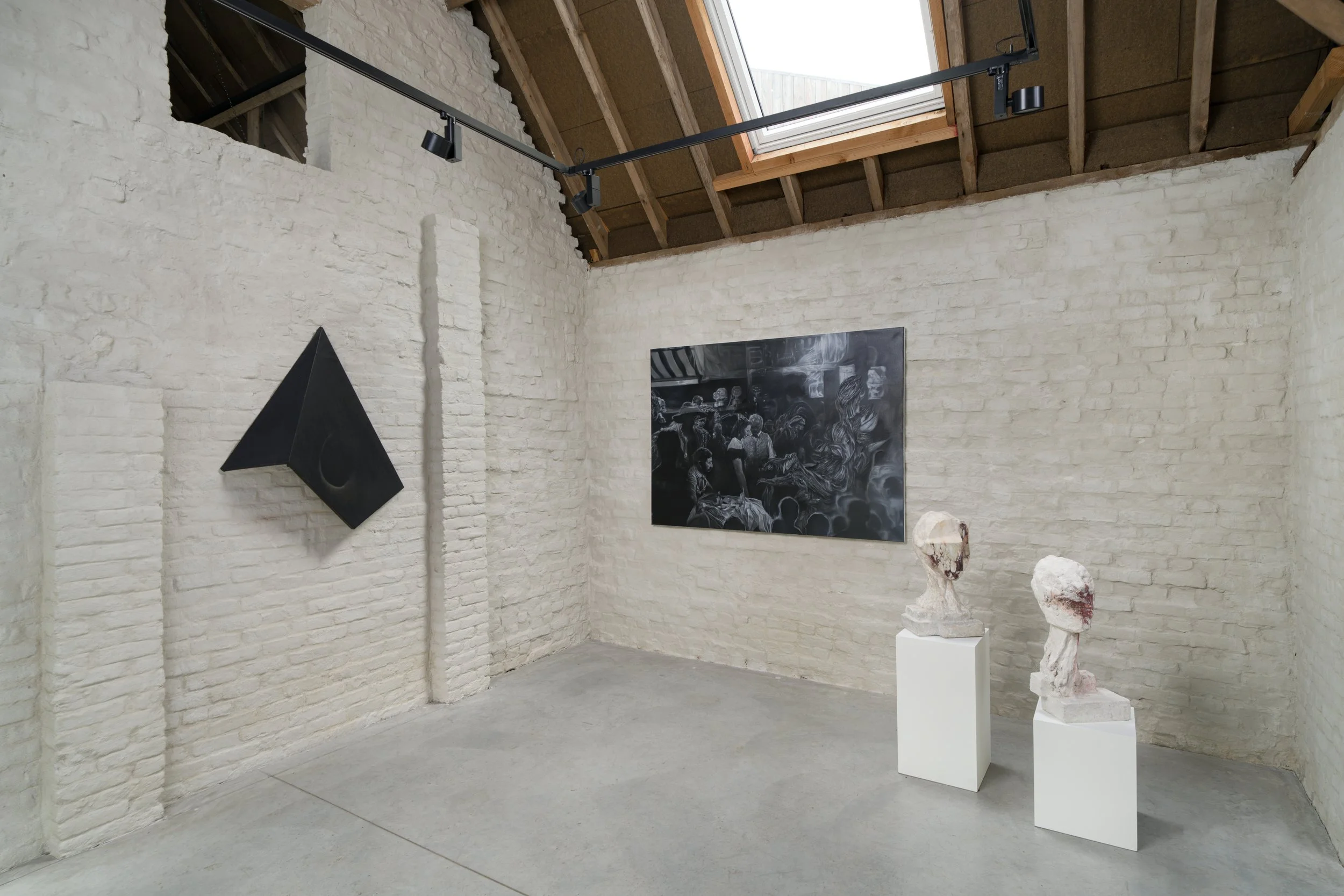Ontomateria
Stephan Balleux, Alexandra Leyre Mein, Ileana Moro, Maryam Najd, Marius Ritiu
11 October — 30 November 2025
Press release
(EN) Ontomateria (n.,neologism) is an exhibition curated by Stephan Balleux. The word Ontomateria, invented by the painter, refers to a form of matter inherently bound to the question of being. The term combines the Greek ontos (being) and the Latin materia (matter), designating not inert substance but a dynamic, structured field through which existence is thought, experienced, and manifested.
Rather than positing a separation between abstract thought and material conditions, ontomateria affirms that existence is always mediated by material forms, whether cognitive, symbolic, technological, or sensory. It describes a mode of matter that is both formative and reflective, capable of conditioning thought while being shaped by it in return.
As a philosophical construct, ontomateria challenges dualistic ontologies. It resists any notion of a pure, detached subjectivity or ideality and instead foregrounds the entanglement of existence with its material substrates. It suggests that to think the human condition is to think from and through matter, not only physical matter, but mental, linguistic, mnemonic, and systemic forms as well.
Thus, ontomateria implies a model of subjectivity and world-formation grounded in material complexity, where matter is not merely a passive receiver of form but an active vector of ontological articulation.
This exhibition brings together five artists whose practices explore the entanglement between material and existence, not as separate dimensions, but as coextensive layers of thought and form. Guided by the concept of ontomateria, these works engage matter not simply as medium, but as ontological vector: that which thinks, remembers, resists, transforms.
Ontomateria is not about what matter "represents"; it is about what matter knows, how it shapes the way being is felt, imagined, and embodied. Across the works in this exhibition, we encounter copper that breathes, plaster that weeps, shadow that listens, and images that dream themselves into dissolution. These are not metaphors, but precise propositions: that thought is always material, and that existence is never without form.
Each artist, in their singular language, invokes matter not as substrate but as interlocutor—a terrain of excavation and intuition, memory and resistance. The exhibition becomes a field of ontomaterial experiences: porous, vital, unstable, and reflective of a human condition in flux and friction with the world it inhabits.
Stephan Balleux (°1974, Brussels) interrogates the limits of perception through illusionistic image construction, confronting the viewer with visual arrangements that disrupt habitual seeing. The materials—whether organic or synthetic—are chosen not for effect, but for their capacity to question the nature of appearance itself. Through layered cultural and historical references—zoology, architecture, cinema, literature—his pieces explore the ontomaterial implications of the image: not only what it shows, but how it materializes perception and reveals the shifting conditions of reality in an era reshaped by algorithms. The image becomes unstable matter—thinking, deceiving, decaying.
Alexandra Leyre Mein (°1979, Brussels) sculpts with an emotional intent that transforms every material she touches into a vessel of existential sensation. Her practice confronts fragility and strength, weaving together the organic and the rigid—wax into bronze, plaster against marble. The resulting forms embody ontomaterial tension, speaking of hypersensitivity as an epistemology. They radiate silence and timelessness, offering a luminous vision of humanity—an ontological exposure through matter.
Maryam Najd’s (°1965, Tehran) work confronts the ontological weight of imagery through a precise interplay of pictorial force and semantic collage. Her practice brings together depictions of women, nations, colonial iconographies, and art-historical codes to interrogate the very materials through which identity and otherness are constructed. The female figure emerges not as subject, but as site of ontomaterial conflict : where stereotype, history, and personal displacement collide. Her matter is image, charged with power and fracture, embedded with existential urgency and reflective thought. Nadj does not illustrate alterity—she materializes it.
For Ileana Moro (°1992, Costa Rica), shadow is substance. Her visual language treats darkness not as absence but as ontological depth, a space where things are not hidden but formed. Her technique embraces intuition, allowing the subconscious to emerge through fluid, open gestures. In her hands, matter becomes meditation—a quiet field in which being is suspended. The works hover between control and release, silence and vibration, presence and withdrawal. In this suspended state, the ontomaterial surface becomes a threshold: not simply what we see, but what silently forms us as we gaze.
For Marius Ritiu (°1984, Satu Mare), copper is not just a metal, but a myth in formation. Through repeated processes of shaping and oxidation, he elevates this industrial material into a metaphysical substance, one that breathes between permanence and decay. His forms, meteors, mountains, staircases, vessels, function as thresholds between immanence and transcendence, between earthbound experience and the vastness of cosmic time. In his work, the ontomaterial dimension of copper becomes evident: it speaks of transformation, of elemental resistance, and of the human urge to connect with something larger than itself.
(NL) Ontomateria (zn., neologisme) is een tentoonstelling gecureerd door Stephan Balleux. Het woord Ontomateria, bedacht door de schilder zelf, verwijst naar een vorm van materie die intrinsiek verbonden is met de vraag naar het zijn. De term combineert het Griekse ontos (zijn) en het Latijnse materia (materie), en duidt niet op een passieve substantie, maar op een dynamisch, gestructureerd veld waarbinnen het bestaan wordt gedacht, ervaren en gemanifesteerd.
In plaats van een scheiding tussen abstract denken en materiële condities, bevestigt ontomateria dat bestaan altijd via materiële vormen wordt bemiddeld—cognitief, symbolisch, technologisch of zintuiglijk. Het beschrijft een vorm van materie die zowel vormend als reflectief is, in staat om denken te beïnvloeden en er tegelijk door gevormd te worden.
Als filosofisch concept daagt ontomateria dualistische ontologieën uit. Het verzet zich tegen het idee van een zuivere, losstaande subjectiviteit of idealiteit, en benadrukt de verstrengeling van bestaan met zijn materiële dragers. Het stelt dat het denken van de menselijke conditie altijd gebeurt vanuit en door materie—niet alleen fysieke materie, maar ook mentale, talige, geheugen-gerelateerde en systemische vormen.
Ontomateria impliceert een model van subjectiviteit en wereldvorming dat geworteld is in materiële complexiteit, waarbij materie niet slechts een passieve ontvanger van vorm is, maar een actieve vector van ontologische articulatie.
Deze tentoonstelling verenigt vijf kunstenaars die de verstrengeling tussen materie en bestaan onderzoeken—niet als gescheiden dimensies, maar als overlappende lagen van denken en vorm. Geïnspireerd door het concept van ontomateria benaderen deze werken materie niet enkel als medium, maar als ontologische vector: datgene wat denkt, herinnert, weerstand biedt, transformeert.
Ontomateria gaat niet over wat materie “voorstelt”; het gaat over wat materie weet, hoe het vorm geeft aan de manier waarop zijn wordt gevoeld, verbeeld en belichaamd. In deze werken ontmoeten we koper dat ademt, gips dat weent, schaduw die luistert, en beelden die zichzelf dromen tot ontbinding. Dit zijn geen metaforen, maar precieze proposities: dat denken altijd materieel is, en dat bestaan nooit zonder vorm is.
Elke kunstenaar gebruikt materie als gesprekspartner—een veld van intuïtie, herinnering, weerstand. De tentoonstelling wordt een ontomateriële ruimte: poreus, vitaal, instabiel, en reflectief voor een mens in frictie met zijn wereld.
Stephan Balleux (°1974, Brussel) bevraagt de grenzen van perceptie via illusionistische beeldconstructies die het gewoonlijke kijken verstoren. De materialen—organisch of synthetisch—worden niet gekozen om hun effect, maar om hun vermogen om het fenomeen van verschijning zelf in vraag te stellen. Via gelaagde culturele en historische referenties—zoologie, architectuur, cinema, literatuur—onderzoeken zijn werken de ontomateriële implicaties van het beeld: niet enkel wat het toont, maar hoe het perceptie materialiseert en de veranderende realiteitscondities onthult in een tijdperk gevormd door algoritmes. Het beeld wordt instabiele materie—denkend, misleidend, vervallend.
Alexandra Leyre Mein (°1979, Brussel) boetseert met emotionele intentie, waarbij elk materiaal dat ze aanraakt transformeert tot een vat van existentiële sensatie. Haar praktijk confronteert kwetsbaarheid en kracht, en verweeft het organische met het rigide—was tot brons, gips tegen marmer. De resulterende vormen belichamen ontomateriële spanning en spreken van hypersensitiviteit als epistemologie. Ze stralen stilte en tijdloosheid uit, en bieden een lumineuze visie op de mens—een ontologische blootstelling via materie.
Maryam Najd (°1965, Teheran) confronteert het ontologische gewicht van beeldvorming via een precieze wisselwerking tussen picturale kracht en semantische collage. Haar praktijk brengt beelden van vrouwen, naties, koloniale iconografieën en kunsthistorische codes samen om de materiële mechanismen te bevragen waarmee identiteit en anders-zijn worden geconstrueerd. De vrouwelijke figuur verschijnt niet als subject, maar als locus van ontomaterieel conflict: waar stereotype, geschiedenis en persoonlijke ontworteling botsen. Haar materie is beeld, geladen met kracht en breuk, doordrenkt van existentiële urgentie en reflectief denken. Najd illustreert alteriteit niet—ze materialiseert het.
Ileana Moro (°1992, Costa Rica) beschouwt schaduw als substantie. Haar visuele taal behandelt duisternis niet als afwezigheid, maar als ontologische diepte—een ruimte waar dingen niet verborgen zijn, maar gevormd worden. Haar techniek omarmt intuïtie, waardoor het onderbewuste via vloeiende, open gebaren naar boven komt. In haar handen wordt materie meditatie—een stil veld waarin zijn wordt opgeschort. De werken balanceren tussen controle en loslaten, stilte en trilling, aanwezigheid en terugtrekking. In deze gesuspendeerde toestand wordt het ontomateriële oppervlak een drempel: niet enkel wat we zien, maar wat ons stilletjes vormt terwijl we kijken.
Marius Ritiu (°1984, Satu Mare) behandelt koper niet enkel als metaal, maar als een mythe in wording. Via herhaalde processen van vormgeving en oxidatie verheft hij dit industriële materiaal tot een metafysische substantie, één die ademt tussen permanentie en verval. Zijn vormen—meteoren, bergen, trappen, vaten—functioneren als drempels tussen immanentie en transcendentie, tussen aardse ervaring en de uitgestrektheid van kosmische tijd. In zijn werk wordt de ontomateriële dimensie van koper zichtbaar: het spreekt van transformatie, van elementaire weerstand, en van de menselijke drang om zich te verbinden met iets dat groter is dan zichzelf.













